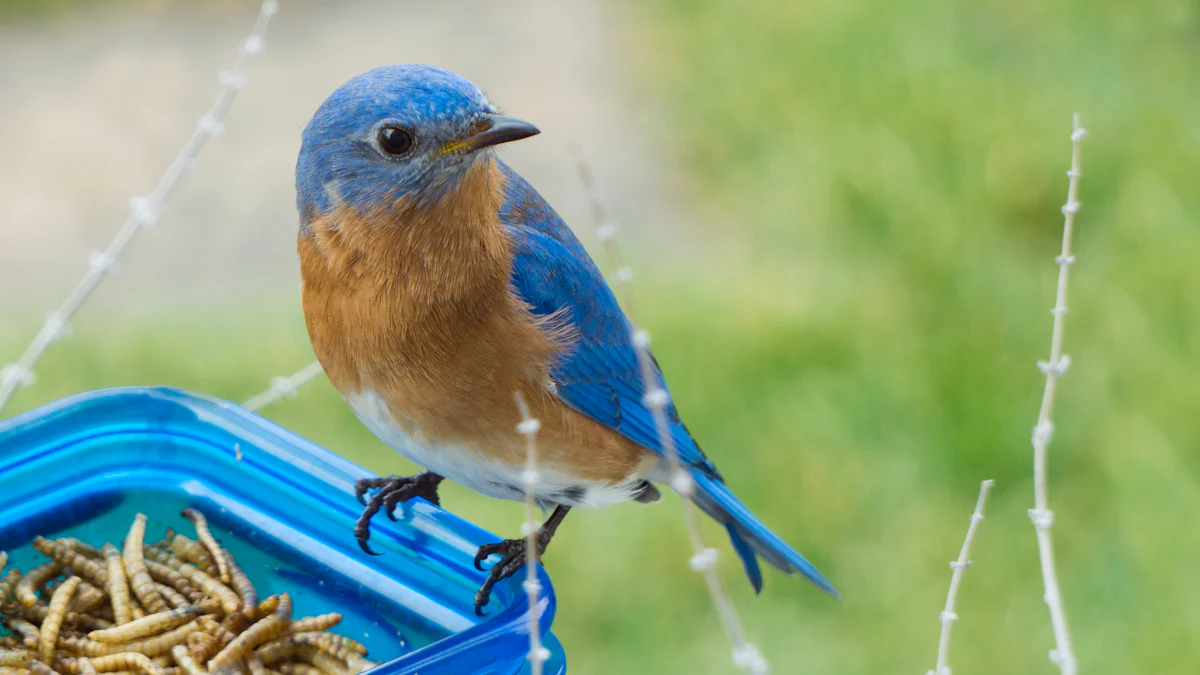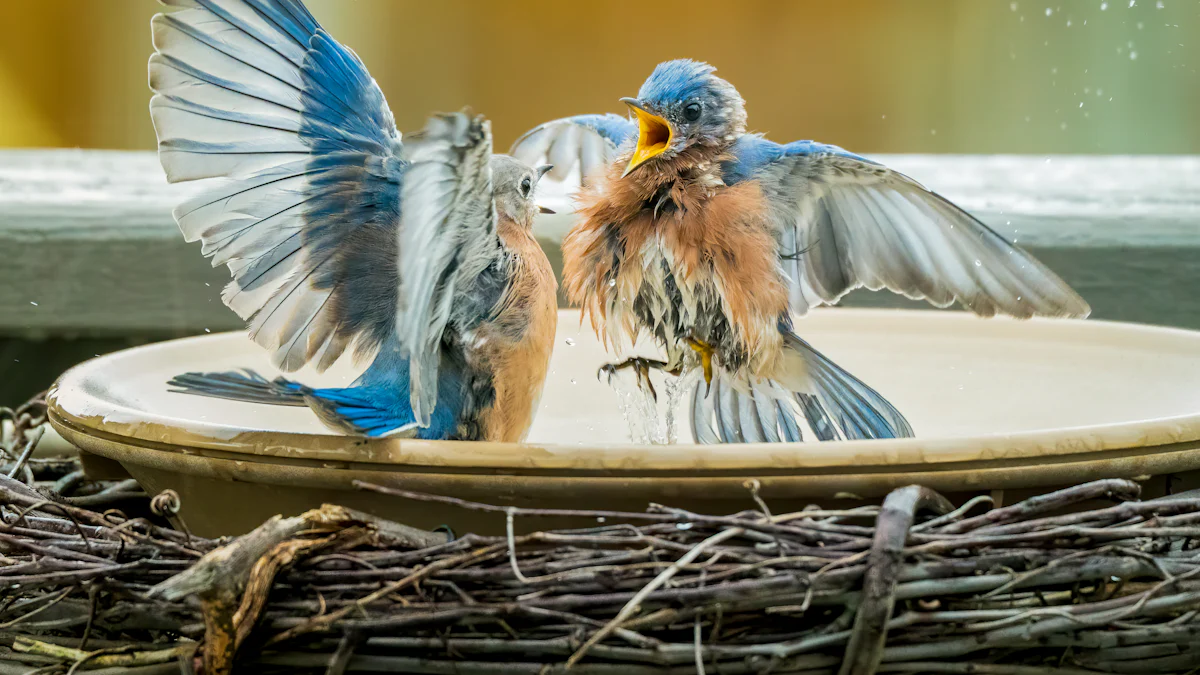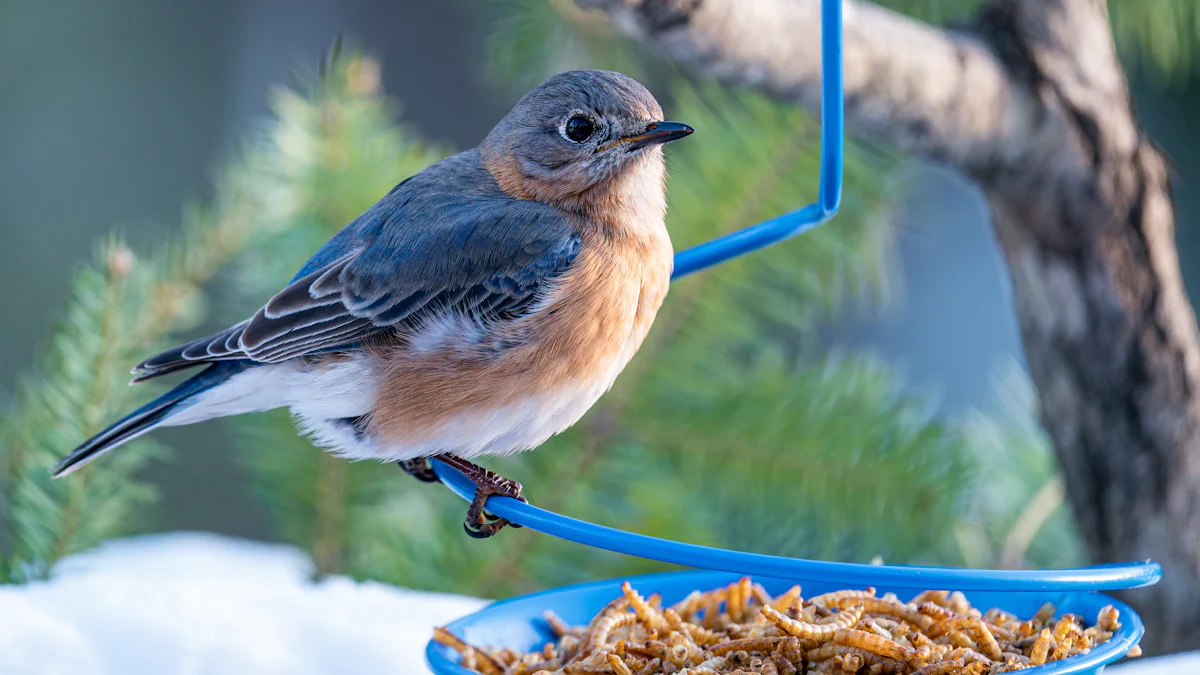
Feeding dried mealworms to birds is a simple way to give them a protein-packed treat. These insects contain about 50% protein and 25% fat, making them ideal for energy and muscle repair. They also provide essential nutrients like potassium and B vitamins. Just 10–15 mealworms per bird daily can boost their diet without overfeeding.
Key Takeaways
- Dried mealworms are healthy snacks for birds. They have about 50% protein and 25% fat. Give each bird 10-15 mealworms daily to stay healthy.
- Soak dried mealworms in warm water for 15-30 minutes. This softens them, making it easier for birds to eat, especially baby birds.
- Change how you feed mealworms based on the season. Give more in spring and winter when birds need more energy. Offer fewer in summer when they can find more food outside.
How Many Dried Mealworms to Feed Birds
Recommended daily quantity for different bird species
When feeding dried mealworms to birds, the amount you offer depends on the species visiting your yard. Some birds, like Bluebirds and Robins, love mealworms and will happily eat them as a treat. Others, like Chickadees and Woodpeckers, may enjoy them occasionally. Here’s a simple guide to get started:
- Start with a small handful of dried mealworms.
- Offer 10–15 mealworms per bird daily.
- Adjust the amount based on how quickly they’re eaten.
For backyard chickens, even fewer mealworms are needed. Just 1–10 mealworms can give them a protein boost without overdoing it. Remember, dried insects are a great addition to any bird’s diet, but they should only be a supplement.
If you notice leftover mealworms in the feeder, reduce the quantity. Overfeeding can attract pests or cause spoilage. To make them more appealing, you can moisten the mealworms slightly. However, don’t leave damp mealworms out for more than a day or two.
Factors influencing the amount of dried mealworms to feed
Several factors affect how many dried mealworms to offer. The type of bird is a big one. For example, Robins, Wrens, and Blackbirds tend to eat more mealworms than smaller species like Blue Tits. Seasonal changes also play a role. Birds need extra energy during breeding season or in winter when food is scarce.
You should also consider the birds’ overall diet. While dried mealworms to birds are rich in protein and fat, they don’t provide all the nutrients birds need. A varied diet that includes seeds, fruits, and suet ensures they stay healthy.
By observing the birds in your yard, you’ll quickly figure out the right amount to feed. Keep experimenting until you find what works best!
Nutritional Benefits of Dried Mealworms to Birds

Protein and fat content for energy and growth
Dried mealworms are a powerhouse of nutrition for birds. They’re packed with about 50% protein and 25% fat, making them an excellent source of energy and nutrients. Protein is essential for muscle repair and growth, while fat provides the fuel birds need to stay active. Whether they’re flying, foraging, or feeding their young, birds rely on these nutrients to thrive.
Compared to other bird food options, dried mealworms stand out for their convenience. They’re easy to store, have a long shelf life, and don’t require refrigeration. This makes them a great alternative to live mealworms, especially if you’re looking for a hassle-free way to supplement your birds’ diet.
Adding dried mealworms to birds’ diets can make a big difference, especially during times when natural food sources are scarce. A small handful goes a long way in providing the protein and energy they need to stay healthy and active.
How dried mealworms support birds during critical life stages
Certain times in a bird’s life call for extra nutrition, and dried mealworms deliver just that. During breeding season, birds need more energy to build nests and feed their chicks. The high protein and fat content in mealworms help meet these demands.
When birds molt, they shed old feathers and grow new ones. This process requires a lot of protein to ensure healthy feather growth. Dried mealworms provide the nutrients needed for strong, insulating feathers that keep birds warm and ready for flight.
Migration is another critical stage. Birds travel long distances and need a compact, nutrient-dense food source to sustain them. Dried mealworms are perfect for this, offering a quick energy boost that helps them complete their journey.
By including dried mealworms in your feeding routine, you’re giving birds the support they need during these vital stages. It’s a simple way to help them thrive year-round.
Best Practices for Feeding Dried Mealworms to Birds
Rehydrating dried mealworms for better palatability
Rehydrating dried mealworms can make them more appealing to birds, especially during critical times like nesting season or hot summer days. Soaking them in warm water for about 15–30 minutes softens their texture, making them resemble live insects. This is particularly helpful for parent birds feeding their chicks, as the moist mealworms are easier for young birds to digest. During summer, this method also provides birds with extra hydration, which is essential when water sources might be limited.
To rehydrate, simply place the mealworms in a bowl and cover them with warm water. After soaking, drain the water and offer the softened mealworms in your feeder. Birds will appreciate the effort, and you’ll likely see more visitors flocking to your yard.
Choosing and setting up the right feeder
The right feeder can make all the difference when offering dried mealworms to birds. Look for feeders with tall sides to prevent mealworms from spilling out. A roof or baffle is a great addition to protect the food from rain, while drainage holes help keep the mealworms dry and fresh. Tamper-resistant features can also keep pests like squirrels away.
You can use a feeder tray or scatter mealworms on the ground to attract more birds. Position the feeder near perches or other feeders to make it easy for birds to find. This setup ensures a steady stream of feathered visitors.
Ensuring feeder placement is safe and visible
Where you place your feeder matters. Birds feel safer when feeders are close to natural shelters like shrubs, trees, or brush piles. These provide quick cover from predators. Position the feeder within several feet of dense bushes or evergreen shrubs for year-round protection.
Make sure the feeder has clear flight paths so birds can access it easily. Surrounding the area with native plants can also enhance the environment, offering birds additional food sources and a natural habitat. A well-placed feeder not only keeps birds safe but also makes your yard a lively birdwatching spot.
Seasonal Considerations for Feeding Dried Mealworms to Birds
Feeding during spring and breeding season
Spring is a busy time for birds. They’re building nests, laying eggs, and raising chicks. This season demands a lot of energy, and dried mealworms can help. Their high protein and fat content give birds the fuel they need to stay active and care for their young.
Here’s why dried mealworms are perfect for spring:
- They provide essential nutrients for nesting and feeding chicks.
- Birds feel fuller and more energized, so they can focus on survival tasks like finding shelter and protecting their young.
You can place mealworms in a feeder or scatter them on the ground to attract birds. If you notice parent birds visiting, consider rehydrating the mealworms to make them easier for chicks to digest.
Feeding during winter and cold months
Winter can be tough for birds. Natural food sources like insects and berries become scarce, and birds need extra energy to stay warm. Dried mealworms offer a reliable solution.
Here’s how they help during winter:
- They provide a quick energy boost when food is hard to find.
- The high fat content helps birds maintain body warmth.
- Unlike some foods, dried mealworms stay intact and edible even in freezing temperatures.
Place feeders in sheltered areas to protect birds from harsh winds. You’ll likely see more visitors as they rely on your yard for nourishment.
Adjusting feeding habits during summer and fall
In summer, birds may not need as much extra food since insects are abundant. However, rehydrated mealworms can provide hydration during hot days. Parent birds may also appreciate them for feeding their chicks.
Fall is a time of preparation. Birds start storing energy for migration or the coming winter. Offering dried mealworms during this season gives them the nutrients they need to build fat reserves. Scatter them near shrubs or trees to mimic natural foraging spots.
By adjusting your feeding habits with the seasons, you’ll support birds year-round and enjoy their company in your yard.
Birds That Eat Dried Mealworms and How to Attract Them

Common bird species that enjoy dried mealworms
Dried mealworms are a favorite treat for many backyard birds. You’ll often see species like:
- Bluebirds
- Robins
- Woodpeckers
- Chickadees
- Orioles
These birds love the protein-packed snack, especially during busy times like nesting or migration. Even chickens can benefit from a few mealworms to boost their protein intake. Just 1–10 mealworms are enough to supplement their diet. Whether you’re feeding wild birds or backyard chickens, dried insects are a fantastic addition to their meals.
Tips for attracting birds to your feeder
Getting birds to visit your feeder might take a little patience, but it’s worth the effort. Here are some tips to help you succeed:
- Use a bird feeder tray or scatter mealworms on the ground to make them easy to spot.
- Place the feeder near perches or other feeders where birds already gather.
- Invest in a specialized mealworm feeder with drainage holes to keep the food fresh.
If larger birds or squirrels become a problem, try feeders with protective cages. These keep the mealworms safe and ensure smaller birds can enjoy the treat. Remember, it might take time for birds to recognize mealworms as food, so don’t give up too quickly!
Tip: Position your feeder in a quiet, accessible spot. Birds feel safer when they can easily fly to nearby trees or shrubs for cover.
Combining dried mealworms with other bird foods for variety
Adding variety to your bird feeding routine keeps things interesting for your feathered visitors. Try these ideas:
- Mix dried mealworms with high-quality seeds for a nutrient-rich snack.
- Press mealworms into suet cakes or blocks to provide extra energy during winter.
- Sprinkle mealworms over fruit slices like apples or oranges to attract fruit-loving birds.
By combining mealworms with other foods, you’ll create a balanced diet that appeals to a wide range of species. Plus, you’ll enjoy watching different birds visit your yard throughout the year!
Note: Dried mealworms are incredibly high in protein—almost 50%! A small amount goes a long way in supporting birds’ health and energy needs.
Feeding dried mealworms to birds is a simple way to provide essential nutrients while attracting a variety of species to your yard. Present them in a feeder tray or scatter them on the ground for easy access. Experiment with feeder types and locations to see what works best. Adjust your feeding practices seasonally to meet birds’ changing needs.
Tip: Rehydrate mealworms during summer to help birds stay hydrated.
FAQ
How do I store dried mealworms to keep them fresh?
Store dried mealworms in an airtight container in a cool, dry place. Avoid direct sunlight or moisture to prevent spoilage. Proper storage ensures they stay fresh longer.
Can I feed dried mealworms to chickens?
Yes! Dried mealworms are perfect for chickens. They’re high in protein—almost 50%. Just 1–10 mealworms daily can boost their diet and improve their overall health.
Are dried mealworms safe for baby birds?
Absolutely! Rehydrate dried mealworms in warm water to soften them. This makes them easier for parent birds to feed their chicks, ensuring proper digestion and nutrition.


